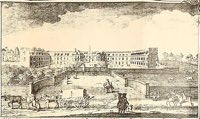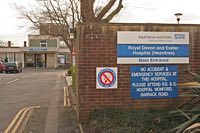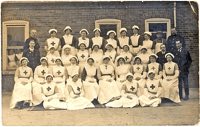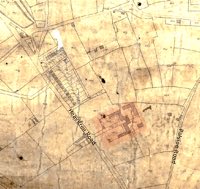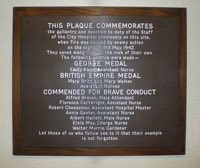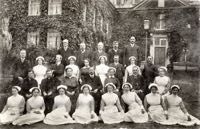
Heavitree Workhouse
or City Hospital and City Workhouse–a history
Researched and written by David Cornforth
Page updated 19th September 2018
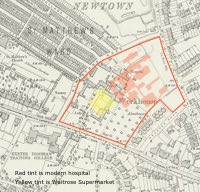 The role of Heavitree Hospital in the last few years has changed, as the Royal Devon and Exeter NHS Foundation Trust, has attempted to rationalise its sites in the city. Heavitree no longer has in patients, but it offers facilities for training, clinics and a haemodialysis unit on the site. However, the roots of the hospital go back to the late 17th Century, when a workhouse was constructed, which gradually morphed into a hospital in the 20th Century.
The role of Heavitree Hospital in the last few years has changed, as the Royal Devon and Exeter NHS Foundation Trust, has attempted to rationalise its sites in the city. Heavitree no longer has in patients, but it offers facilities for training, clinics and a haemodialysis unit on the site. However, the roots of the hospital go back to the late 17th Century, when a workhouse was constructed, which gradually morphed into a hospital in the 20th Century.
The first workhouse
In 1667, Canon John Bury, rector of St Mary Major, left the sum of £40 per year to the parish of St Sidwell so that "All ye poore people of that Parish that should be able to work should be maintained therein and kept to work." A site was found in the present car park of the Triangle, and the City Workhouse was built. (1)
The second workhouse
At the end of the century, the state of the care for the poor in the nation was of concern, and Exeter was one of the first cities to respond to the Poor Law Act of 1698. They created "a Corporation to continue forever to consist of the Mayor and Alderman and of forty other persons... for and towards the relief of the Poor." (1) The city purchased the St Sidwell workhouse and decided to close it. A new site on a healthy, elevated piece of ground in St Sidwell's, on the London road was acquired, and work started in 1699 to build, in locally manufactured brick, a new workhouse.
The building was designed by Richard Mitchell–at the centre was a large chapel, surmounted with a cupola and clock. There were apartments for the governor, and rooms for offices and committee meetings. the wings were divided into wards, with capacity for several hundred paupers. Behind, was further superior accommodation for people who were paid for by their parish. Workshops were provided to employ the inmates. At the front was a large grassed area, with rows of trees, enclosed by a wall, for the recreation of the inmates. By 1707 the whole complex was complete. (1)
Referred to as the Workhouse, the inmates were put to work spinning worsted and the manufacture of clothing. In 1701 a beadle was appointed at a cost of £18 per annum "to suppress the beggars outside the workhouse, to keep the poor in good order within the House, to train the poor, and perform all cures to the best of his skill on wounds and sore legs". All inmates could be punished by whipping with thongs at a whipping post and confined to a 'dark house'.
Workhouse and City Hospital
In 1718 Mr John Patch was employed as a surgeon at £20 per annum, a post he retained until he become the first surgeon at the Devon and Exeter Hospital in Southernhay in 1741.
When the Devon and Exeter Hospital was planned at Southernhay, by a group of influential country gentlemen, and representatives of the church, the Corporation decided to rename the workhouse the City Hospital. There was a certain amount of rivalry between the one, supported by the city, and the other supported by the church the gentry.
The City Hospital opened in 1741, with forty beds and £100 annual funding from the Corporation. Physicians who signed up for the City Hospital included Dr John Jago and Dr George Bent. However, all did not go well with the hospital, and it closed in 1754 from a lack of funds, and competition from its more glamorous rival, the Devon and Exeter. The complex reverted to being a workhouse, with some medical facilities.
Between 1821 and 1858 additional buildings were constructed to expand the medical side beyond those needed for the inmates, and the workhouse started admitting fever and maternity cases from the whole of the city.
Inmates, including children were employed in the Corporation run brick works at Clifton Hill, in the 19th Century. From 1874, many of the children at Newtown School were from the workhouse and would be accompanied to school, wearing regulation hobnail boots, and dressed in navy and black.
A new infirmary
The Local Government Board pressed the city, in 1902, to provide more help for the unwell poor, and plans were drawn up for a new infirmary. In 1904, an advert appeared for builders to contract for the work. The foundation stone was laid on 3 November, the new building being at the rear of the existing workhouse and hospital. By August 1905, the Guardians of the Poor were tendering for furniture, cabinet makers and ironmongers to fit out the infirmary. A transformer was also installed in the grounds to provide electricity to the buildings. The infirmary was opened on 18 October by Sir C T Dyke Acland,, Bart., President of the South Western poor Law Conference. The infirmary had 156 beds, and wards named after Dr Pereira-Gray and Sir Edward Seaward.
The new facilities were to be extensive, comprising of five blocks; an administrative block, with the other four blocks interconnecting through glazed corridors. The east and west ward blocks were for males and females respectively. A bungalow building, north of the main range was for maternity, while another bungalow, on the east of the complex was for treating TB, then known as consumption–the last block was never built. The whole lot was of red brick with Bath stone dressing, concrete sills and slate roofs. The men's ward and maternity bungalow escaped the destruction in 1942, and still exist.
The buildings generally are of local red brick, with plain Bath stone dressings, concrete sills, and slate roofs. The whole complex cost £16,000, and the architect was Mr R M Challice, with Ham and Passmore the builders.
Up to about 1932, the inmates for the remaining workhouse were increasingly casuals, or vagrants, who would be given a bed for the night in small cells, known as the Z-block or Casual Ward. They had to break half a ton of stone, of which, the pieces had to be passed through agrid if a certain size, for use in road building, during their stay to pay for their keep. The last entry in the newspapers regarding an inmate at the workhouse was in 1932.
A derelict section of the hospital building was refurbished in 1930, to become a private nursing home of sixteen beds. For two guineas a week you could be attended by a doctor from the Royal Devon and Exeter Hospital and even have surgery in the private operating theatre. At the outbreak of war in 1939, the private facility closed as all the hospitals in Exeter responded to the national emergency.
 In February 1914, a Children's Home, again designed by Mr Challice, was opened, at a cost of £6,300, on the Heavitree Road, to the side of the workhouse. It could accommodate 66 children, hence removing them from the workhouse. The building was requisitioned in November 1914 to became VA Hospital No. 3, one of eight military hospitals established in Exeter during First War hostilities. It was returned to the Exeter Court of Guardians in December 1919.
In February 1914, a Children's Home, again designed by Mr Challice, was opened, at a cost of £6,300, on the Heavitree Road, to the side of the workhouse. It could accommodate 66 children, hence removing them from the workhouse. The building was requisitioned in November 1914 to became VA Hospital No. 3, one of eight military hospitals established in Exeter during First War hostilities. It was returned to the Exeter Court of Guardians in December 1919.
Destroyed by bombs
The City Hospital was the one hospital in Exeter that suffered serious destruction and loss of life in the May 1942 blitz. There were 194 patients in the hospital that night, when high-explosive bombs and thousands of incendiaries fell on the city. The hospital was hit by the incendiaries, and despite the heroic efforts of the staff, 18 bedridden patients on the first floors of Ward Block A and B in the old hospital were killed.
Nursing staff were commended for their efforts in trying to save their patients. Night nurse Mrs Emily Knee stated "...We succeeded in getting many of the patients out, but when we came to rescue those in Block A Sick Ward the fire was raging and the stairs were ablaze, and we could not get to them". Nurse Knee received the George Medal for her bravery, while two British Empire Medals were awarded that night and seven commended for brave conduct. All the records for the hospital were also lost in the conflagration.
The bombing destroyed the old 1707 workhouse/hospital buildings including the newer Z-block, or casual ward. The infirmary block lost the male wing, while the female wing, maternity bungalow and central administration block survived, and are still in use today.
The Children's Home was pressed into service as a temporary hospital, along with Exe House and Magdalen House until rebuilding.
Part of the NHS
On 5th July 1948, what remained of the City Hospital was absorbed into the NHS. Since then, the hospital has seen considerable rebuilding, as it became a centre for maternity, dentistry and geriatrics.
The maternity unit closed in June 2007 and moved to a new £31.5 million facility which opened for business at 8.30am on the 15th June 2007. The maternity unit had delivered 106,000 babies since it was opened in 1954, with Benjamin Hudson the last baby to be born at Heavitree, when he was delivered at 8.56am on the 15th June 2007, weighing 9lb 10oz.
The modern Heavitree Hospital has an emergency dental access centre, a dental school and haemodialysis unit in a large block on the site of the male wing destroyed in the war. There are also training facilities, a minor surgery unit and many outpatient clinics at the hospital. The nurses accommodation was sold for a Waitrose supermarket and the Children's Home has been converted to student accommodation.
Sources: (1) Alexander Jenkins–History of the City of Exeter. The Royal Devon and Exeter Hospital by Knox and Gardner-Thorpe. Exeter Burning by Peter Thomas. British Newspaper Archive. Map above from the National Library of Scotland used under Creative Commons.
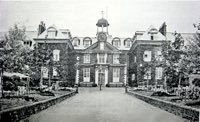
Compare this photo of the workhouse with the engraving to the left. The workhouse site is now occupied by Waitrose.
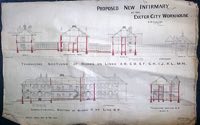
A plan of the infirmary opened in 1905. The infirmaryl was behind the old workhouse/workhouse. The left hand block is shown in the photo below.
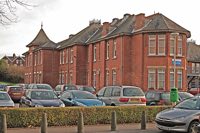
The west side of the female ward. The male ward that was destroyed in the war was almost identical. Authors photo.
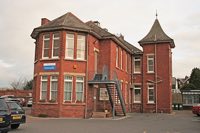
The female infirmary and ward block at Heavitree. Now used for procurement and logistics. Authors photo.
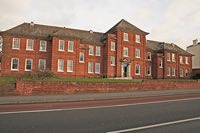
The Children's Home opened in February 1914. It was requisitioned as a war hospital in December 1914. It is now student accommodation. Authors photo.
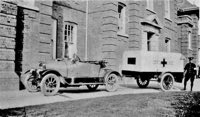
The First War VA Hospital No 3, (Children's Home) with an ambulance trailer hauled by a private car. Photo courtesy Paul Tucker
│ Top of Page │
